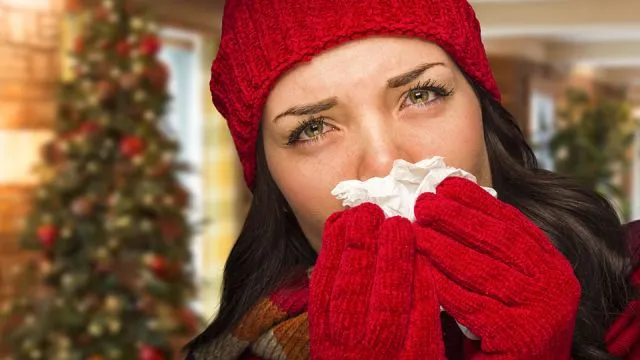
- Share on Facebook79
- Share on Pinterest
- Share on Twitter
Is your Christmas tree making you sick? If you‘re sniffing and sneezing this holiday season, the answer could be yes. And the reason may surprise you. But don’t despair, you don’t have to forgo your festive tree. Here’s what you need to know about “Christmas tree syndrome” and what you can do to prevent it.
Yes, your Christmas tree could be making you sick
It might be the center of holiday festivity but your Christmas tree could actually be making you ill. Due to a condition known as “Christmas tree syndrome,” many Americans suffer increased hay fever-like symptoms during the holiday season. Experts reveal why.
According to a study published in the Annals of Allergy, Asthma and Immunology, epidemic respiratory illnesses in both adults and children occur around December 25 each year. Most notably one week prior and one week after Christmas day.
Early research found that ragweed, grass and tree pollen on the tree bark were likely causes. Then, in 2007, researchers found that mold spores common to Christmas trees significantly increased in the warmth of the home. Mold, often associated with decay, is a small fungus that forms on organic matter.
Asthma sufferers beware!
If you’re not sensitive to mold, no problem. But if you are, look out! Experts warn that asthma sufferers should be on high alert since each year thousands of patients are admitted to hospitals in December as a result of mold growing on the holiday tree. Since most Christmas trees are cut in advance of the holidays, they begin to die. Decay sets in within a couple of days. And when stored in a moist environment, they become an even greater source of mold.
Mold is not uncommon on outdoor vegetation. But when a plant or tree is brought indoors, the normal mold level in a home increases significantly. While difficult to predict, the University of Minnesota suggests exposure to mold is most often associated with the following allergy symptoms:
- Nasal and sinus congestion
- A cough and sore throat
- Chest tightness
- Wheezing
- Breathing difficulty
- Increased asthma
- Nosebleeds
- Upper respiratory tract infection
- Headaches
- Skin and eye irritation
Here’s why Christmas trees have mold issues
Christmas trees can take up to six years to grow before they are cut. During this period of time, the tree can collect not only mold but also dust, pollens and allergens. And while it may not be visible to the naked eye, it doesn’t mean it’s not there. Christmas trees are coniferous softwoods and have a particularly high moisture content — and mold loves moisture.
Here’s what you can you do to protect your family
Before bringing your cut tree inside, bang it on the base to release any dead needles. Then spray it with a (preferably natural and organic) fungicide, available at most garden centers. You can also make your own natural formula. Simply combine one gallon of water with three tablespoons of baking soda. Add one tablespoon of bleach and one teaspoon of dishwashing liquid. Fill a spray bottle and spray the entire tree outdoors, allowing it to dry for 24 hours. Carefully dry any remaining moisture before bringing your tree indoors.
Meanwhile, keep your tree in a well-ventilated area since mold thrives in poor ventilation. If possible, open a window. For added protection, place an air purifier in the same room as your live Christmas tree. Let it run for three hours or longer to clear the air of airborne mold spores. Finally, don’t leave your Christmas tree in your home for more than seven days.
What about an artificial tree?
If all else fails, you can certainly opt for an artificial Christmas tree. However, be warned. Some artificial Christmas trees can also cause allergic reactions, says the Christmas Tree Association. Trees that have not been properly stored can accumulate significant amounts of dust, mold spores and other irritating debris. Moreover, some of the materials used to manufacture artificial Christmas trees may cause sinus irritation for those who are sensitive.
So, regardless of what type of tree you buy, it’s advisable to clean the tree off prior to bringing it into your home. In addition, ornaments also collect dust while in storage. So, you may want to gently dust each ornament before placing on the tree.
Christmas is a wonderful time of year. Why spoil it with sneezing and sniffles, or worse, a trip to the emergency room? A little preemptive care for your Christmas tree can make a world of difference for sensitive people. Happy holidays!
— Katherine Marko
- Share on Facebook79
- Share on Pinterest
- Share on Twitter

